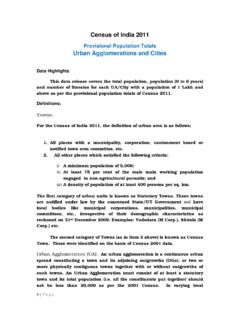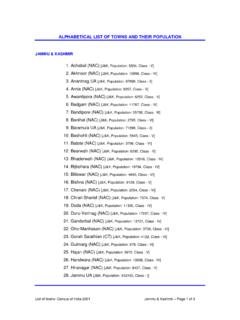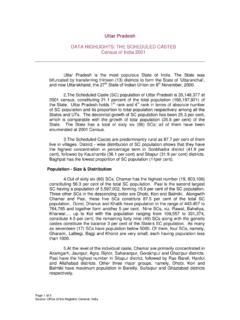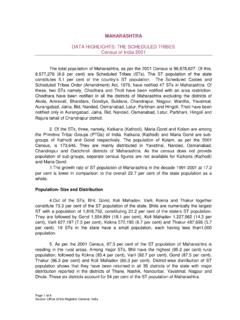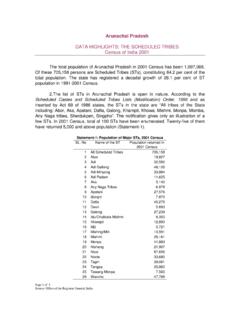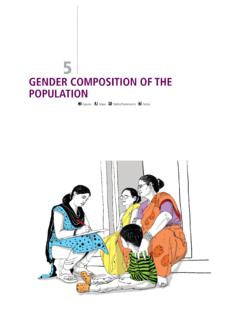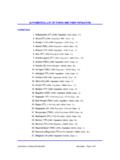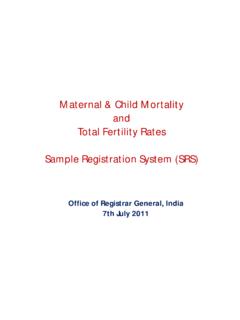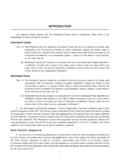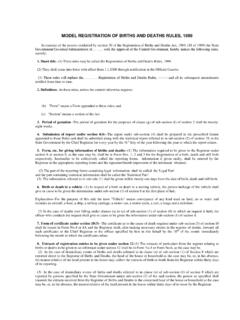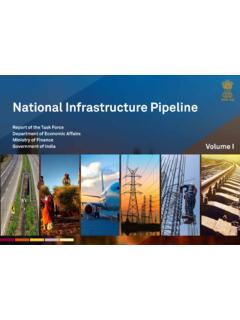Transcription of POPULATION COMPOSITION - Census of India Website
1 11 CHAPTER - 2 POPULATION COMPOSITION The data on POPULATION by age and sex is vital for demographers, health administrators etc. for planning and evaluation of various developmental and health programs. The classification of rural/urban, sex and marital status by age unveils the characteristics of POPULATION COMPOSITION and provides disaggregated data for target oriented projects. Being one of the most important demographic characteristics, data on age is collected and updated in both half-yearly surveys of SRS for all the members of the household covered in the sample units. As per available data from SRS, there has been a gradual decline in the share of POPULATION in the age group 0-14 from to per cent during 1971 to 1981 and to percent during 1991 to 2011 , whereas, the proportion of economically active POPULATION (15-59 years) has increased from to percent during 1971 to 1981 and to per cent during 1991 to 2011 .
2 On account of better education, health facilities and increase in life expectancy, the percentage of elderly POPULATION (60+) has gone up from to percent and to percent respectively during the periods under reference. Marital status and Female mean age at marriage are essential constituents to monitor fertility and POPULATION growth. The data on marital status has been included in SRS from 1991, whereas on Female mean age at marriage is from 1990. There is a marginal increase in the proportion of married Female from in 1991 to in 2011 , whereas the proportion of widowed/divorced/separated female has remained stagnant at The mean age at effective marriage for Female has improved from years in 1990 to years in 2011 . This chapter provides data on percentage distribution of POPULATION by age, sex and residence for all broad age groups from 0-4, 0-14, 15-59 and 60+ for India and bigger States.
3 It also includes data on percentage distribution of POPULATION by marital status for total POPULATION , 10+ and 15+ ages by sex and residence. The state-wise variations in Female age at effective marriage and their corresponding proportions have also been presented in this chapter. 12 Age COMPOSITION Age COMPOSITION by residence and broad age groups 0-14, 15-59 and 60+ for the year 2011 at the National level is shown below in Statement 3. The age group 0-14 is further sub-categorized into the age groups 0-4, 5-9 and 10-14. It is observed that for most of the age groups, Male-Female differences in the age distribution of POPULATION are negligible except in the combined age-group of 0-14, 15-59, 60+ & 65+. In the age-group 0-14, Male POPULATION is about one percent more than Female, whereas in the age-group 60+ as also 65+, percentage of Female is percent more than Male.
4 The proportion of young children in the age group 0-4 and also the proportion of POPULATION in the age group 0-14 are higher in rural areas than in urban areas both for Male and Female. A higher proportion of Male and Female in the working age group 15-59 live in urban areas as compared to rural areas. Chart 2 gives pictorial presentation of data shown in Statement 3. Table 1 gives percentage distribution of estimated POPULATION by quinquennial age groups, sex and residence for India and bigger States. Statement 3 Percentage distribution of POPULATION by broad age groups to total POPULATION by sex and residence, India , 2011 Residence Sex Broad age groups (years) 0-4 5-9 10-14 0-14 15-59 60+ 15-64 65+ Total Total Male Female Total Rural Male Female Total Urban Male Female Note: Total percentage may not add to 100 on account of rounding in broad age groups 13 Chart 2.
5 Percentage distribution of POPULATION by broad age groups and residence, India , 2011 14 Percentages share of POPULATION in the selected age groups for bigger States by residence and sex are given in Statements 4 to 7. Statement 4 gives the percentage of POPULATION below 5 years of age. At the National level, percent POPULATION in urban areas constitutes below 5 years of age as against percent for rural area. Sex differences in the share of child POPULATION are negligible both in rural and urban areas. The share of male child POPULATION is about 1 percent higher in rural area of Kerala. Among the bigger States, the percentage of child POPULATION in rural areas varies from in Kerala to in Bihar. In urban areas, such variation is from in Jammu and Kashmir to in Bihar.
6 Chart 3 shows the pictorial presentation of percentage of child POPULATION for bigger States. Statement 4 Percentage of POPULATION in the age group 0-4 years to total POPULATION by sex and residence, India and bigger States, 2011 India and bigger States Total Rural Urban Total Male Female Total Male Female Total Male Female India Andhra Pradesh Assam Bihar Chhattisgarh Delhi Gujarat Haryana Himachal Pradesh Jammu & Kashmir Jharkhand Karnataka Kerala Madhya Pradesh Maharashtra Odisha Punjab Rajasthan Tamil Nadu Uttar Pradesh West Bengal 15 16 Percentage of
7 POPULATION of age less than 15 years for India and bigger States by sex and residence is given below in Statement 5. At the National level, percent of rural POPULATION in the year 2011 is below 15 years of age against percent for urban areas. Percentage of POPULATION below 15 years of age in rural areas varies from in Kerala to in Bihar. In urban areas, it varies from in Jammu & Kashmir and West Bengal to in Bihar. Chart 4 gives the pictorial presentation of percentage of persons below 15 years of age for bigger States by residence. Statement 5 Percentage of POPULATION in the age group 0-14 years to total POPULATION by sex and residence, India and bigger States, 2011 India and bigger States Total Rural Urban Total Male Female Total Male Female Total Male Female India Andhra Pradesh Assam Bihar Chhattisgarh Delhi Gujarat Haryana Himachal Pradesh Jammu & Kashmir Jharkhand Karnataka Kerala Madhya Pradesh Maharashtra Odisha Punjab Rajasthan Tamil Nadu Uttar Pradesh West Bengal 17 18 Statement 6 given
8 Below provides percentage of POPULATION in the working age group 15-59 years for India and bigger States by sex and residence. At the National level, the age group 15-59 contributes percent in rural areas and percent POPULATION in urban areas. In rural areas the percentage varies from in Bihar to in Andhra Pradesh. In urban areas the same varies from in Bihar to percent in Jammu & Kashmir and Himachal Pradesh. Chart 5 gives the pictorial presentation of percentage of POPULATION in the age group 15-59 years by residence. Statement 6 Percentage of POPULATION in the working age group 15-59 years by sex and residence, India and bigger States, 2011 India and bigger States Total Rural Urban Total Male Female Total Male Female Total Male Female India Andhra Pradesh Assam Bihar Chhattisgarh Delhi Gujarat Haryana Himachal Pradesh Jammu & Kashmir Jharkhand Karnataka Kerala Madhya Pradesh Maharashtra Odisha Punjab Rajasthan Tamil Nadu Uttar Pradesh West Bengal 19 20
9 Percentage of aged persons (60 years and above) for India and bigger States by sex and residence is given below in Statement 7. At the National level, percentage of aged (60+) POPULATION is COMPOSITION of 60+ aged female POPULATION is higher in all of the bigger States except Assam, Bihar, Himachal Pradesh, Jammu & Kashmir and Jharkhand. In rural areas POPULATION in the age group 60+ constitutes percent of the total POPULATION and variation in aged POPULATION ranges from percent in Delhi to percent in Kerala. The urban proportion of aged POPULATION in most of the States is lower than the corresponding rural share except for Assam, Bihar, Delhi, Jammu & Kashmir, Jharkhand, Rajasthan, and West Bengal. The Pictorial presentation of percentage of old age POPULATION by residence for bigger States is given in Chart 6.
10 Statement 7 Percentage of POPULATION in the age group 60 years and above to total POPULATION by sex and residence, India and bigger States, 2011 India and bigger States Total Rural Urban Total Male Female Total Male Female Total Male Female India Andhra Pradesh Assam Bihar Chhattisgarh Delhi Gujarat Haryana Himachal Pradesh Jammu & Kashmir Jharkhand Karnataka Kerala Madhya Pradesh Maharashtra Odisha Punjab Rajasthan Tamil Nadu Uttar Pradesh West Bengal 21 22 Marital
